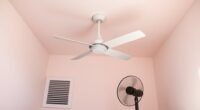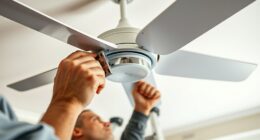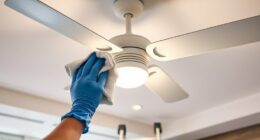To measure your garage ventilation fan properly, start by accurately measuring your garage’s length, width, and ceiling height using a tape measure. Calculate the garage volume in cubic feet. Then, determine the required airflow in CFM based on the number of air changes per hour needed. Use an anemometer to check the airflow velocity at the fan’s outlet, making sure airflow is even and steady. Keep reading to learn how to optimize your fan’s efficiency and performance.
Key Takeaways
- Measure garage dimensions accurately (length, width, ceiling height) to calculate total volume for ventilation needs.
- Use an anemometer to record airflow velocity at the fan’s intake or exhaust point for precise CFM measurement.
- Confirm airflow distribution is even and steady to ensure the fan meets the required ventilation rate.
- Check duct placement and condition to prevent obstructions and ensure accurate airflow readings.
- Test the fan’s noise, vibration, and overall performance after installation to verify proper operation and efficiency.
Understanding the Importance of Proper Ventilation Measurement

Understanding the importance of proper ventilation measurement is essential because inadequate airflow can lead to poor air quality, lingering fumes, and even safety hazards in your garage. When you measure ventilation correctly, you ensure airflow patterns are effective and consistent, preventing dangerous buildup of fumes or moisture. Ventilation codes set standards for airflow rates and system performance, so adhering to them keeps your space safe and compliant. Accurate measurements help you identify if your current fan setup meets these codes and performs efficiently. Without proper measurement, you risk under-ventilating, which compromises safety, or over-ventilating, which wastes energy. Paying attention to airflow patterns and following ventilation codes guarantees your garage remains a healthy, safe environment. Additionally, understanding local regulations and how they apply to your ventilation system can help avoid penalties and ensure optimal performance.
Identifying the Key Factors for Fan Selection
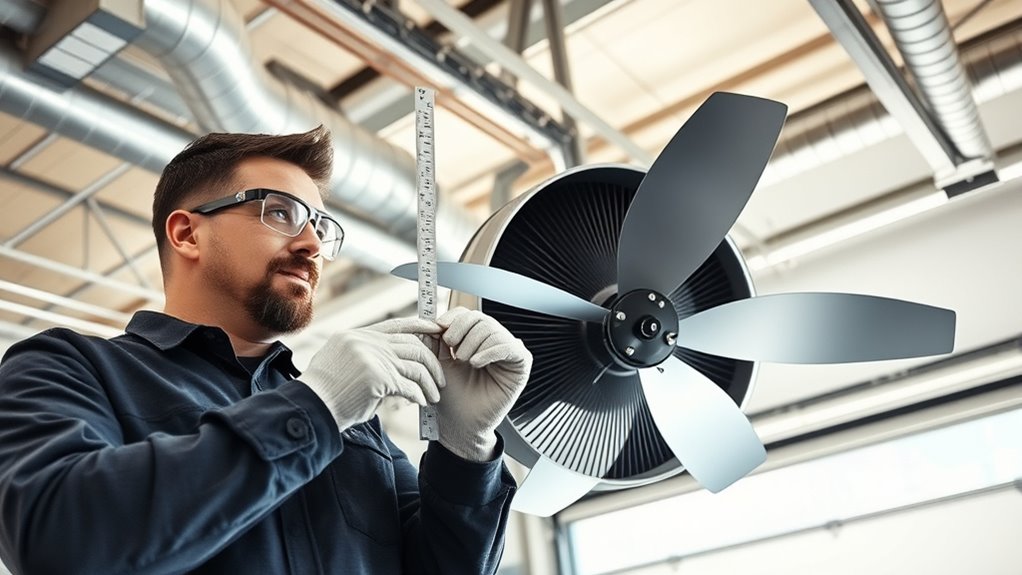
Choosing the right garage ventilation fan depends on several key factors that guarantee effective air exchange and safety. First, consider ventilation standards to ensure the fan meets local codes. Fan noise is also essential; a quieter model improves comfort. Power capacity must match your garage size and airflow needs. Durability and ease of maintenance impact long-term performance. To help compare options, review this table:
| Factor | Consideration |
|---|---|
| Ventilation Standards | Compliance with local safety and building codes |
| Fan Noise | Decibel levels suitable for your environment |
| Airflow Capacity | Cubic feet per minute (CFM) based on garage size |
| Durability | Material quality and warranty coverage |
| Maintenance | Accessibility and ease of cleaning |
Prioritize these factors to select an efficient, compliant, and quiet ventilation fan. Additionally, understanding proper installation techniques ensures optimal performance and safety.
Calculating the Required Air Changes per Hour
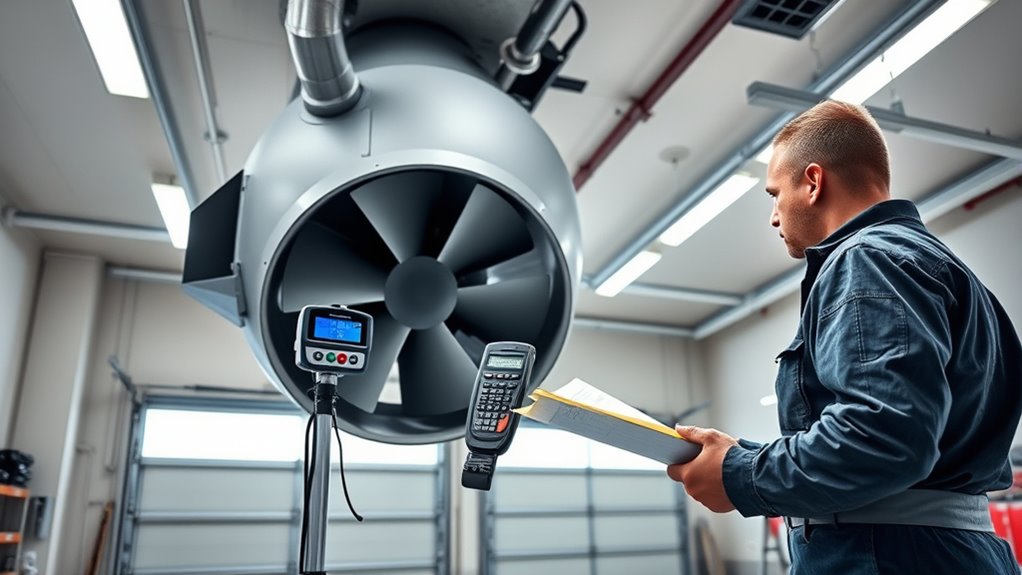
To guarantee your garage remains well-ventilated and safe, calculating the appropriate number of air changes per hour is essential. This ensures good air quality by removing pollutants, fumes, and excess humidity. Typically, garages need about 6 to 8 air changes per hour, but this can vary based on usage and size. To determine this, measure your garage’s volume in cubic feet or meters. Then, decide on the airflow rate needed to achieve the desired air changes. Keep in mind that higher airflow can increase noise levels, so choose a fan that balances effective ventilation with acceptable noise. Regularly calculating and adjusting your ventilation rate helps maintain ideal air quality while minimizing noise disruptions, keeping your garage safer and more comfortable. Additionally, selecting appropriate ventilation fans can optimize airflow and energy efficiency.
Measuring Your Garage’s Dimensions Accurately
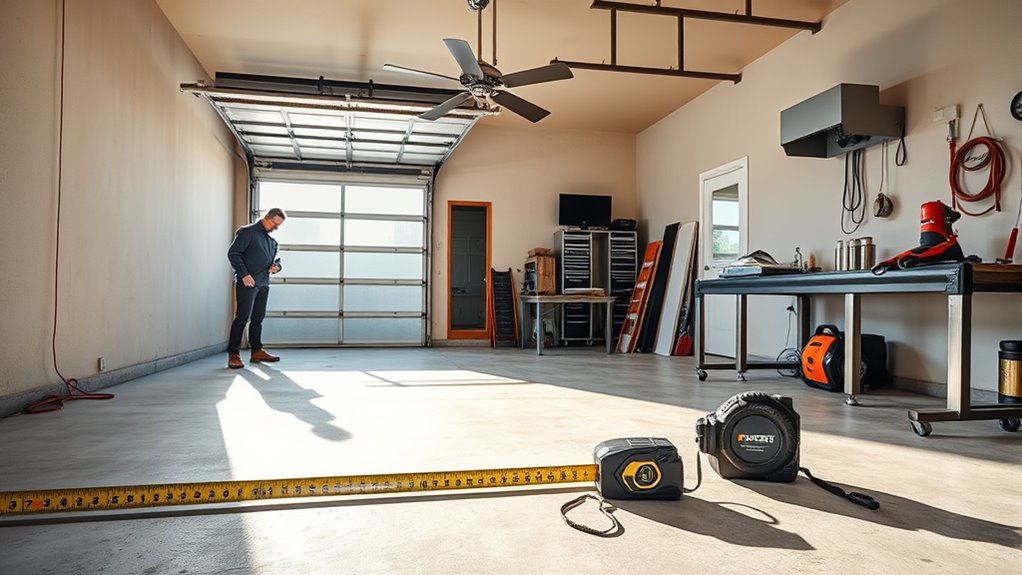
To measure your garage’s dimensions accurately, start by recording the precise length and width. Don’t forget to gauge the ceiling height, as it affects ventilation needs. Accurate measurements ensure you select the right fan for effective airflow. Additionally, consider the headphone jack type used in your devices to ensure compatibility when testing electrical components or troubleshooting.
Precise Length and Width
Accurately measuring your garage’s length and width is essential for selecting the right ventilation fan. Precise dimensions help guarantee your exhaust system is effective and your garage insulation isn’t compromised. Use a tape measure to record the exact length and width, marking the measurements clearly. Avoid guessing or rounding numbers, as even small discrepancies can affect airflow calculations. Keep in mind that larger garages need more powerful fans to move air efficiently. Proper measurements also help determine if your current setup supports ideal ventilation. Accurate dimensions ensure you choose a fan that matches your garage’s size, improving air quality and maintaining insulation integrity. Taking the time to measure carefully pays off in better ventilation performance and energy efficiency. Additionally, understanding the contrast ratio of your ventilation system can help you evaluate its effectiveness in different conditions.
Accurate Ceiling Height
Measuring your garage’s ceiling height guarantees your ventilation fan fits properly and operates efficiently. First, locate the ceiling joist, which provides a reliable reference point. Use a tape measure to determine the height from the floor to the ceiling joist. If your garage has insulation, be sure to measure through it, not around it, to get an accurate reading. Knowing the ceiling height helps you select a fan that matches your space and ensures proper airflow. An accurate measurement also prevents issues with installation or performance. Remember, an improperly sized fan can lead to poor ventilation or noise problems. Taking precise measurements of your garage’s ceiling height, considering insulation and ceiling joists, ensures your ventilation system functions effectively. Additionally, understanding the physical healing process after any modifications can help you plan for maintenance or renovations if needed.
Determining the Necessary CFM for Your Space
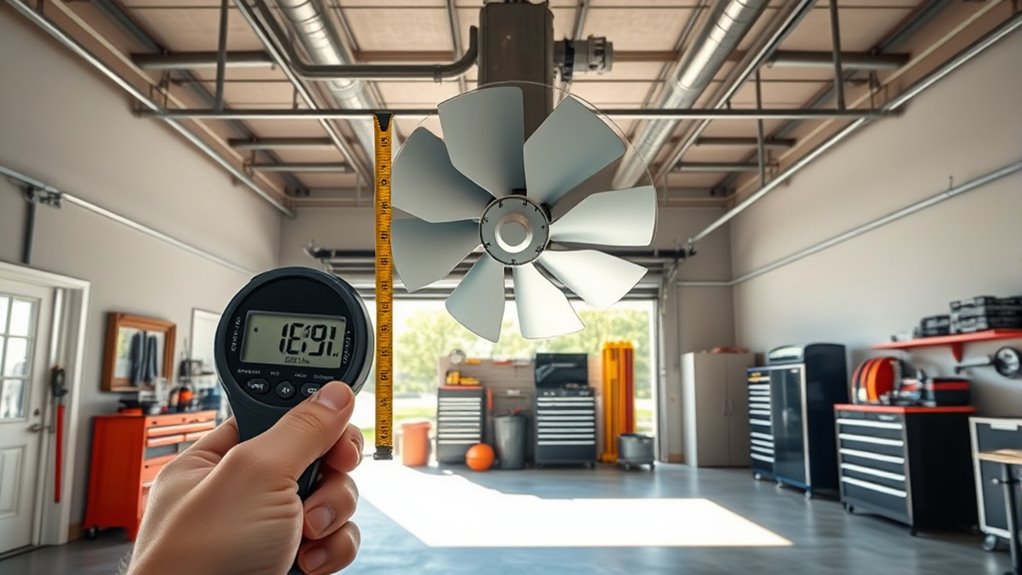
Determining the right CFM (cubic feet per minute) for your garage ventilation fan is vital to guarantee proper airflow and air quality. To do this, assess the size of your garage by multiplying its length, width, and height to find the total volume. For good air quality and odor control, you typically need to exchange the air every 3 to 5 minutes. Divide the total volume by the desired air exchange time to get the necessary CFM. For example, a 20x20x10-foot garage requires a fan that can move at least 800 CFM to ensure fresh air and control odors effectively. Selecting the correct CFM guarantees your space remains safe, comfortable, and well-ventilated.
Using a Anemometer to Measure Airflow Velocity

To make certain your garage ventilation fan is performing as expected, you’ll need to measure the airflow velocity directly. Using an anemometer allows you to do this accurately by placing it at strategic fan locations. Focus on proper fan placement and observe airflow patterns to ensure even ventilation. Hold the anemometer perpendicular to the airflow, avoiding obstructions that could skew results. Consistent readings will confirm the fan’s efficiency. Remember, airflow should be strong and uniform, not turbulent or uneven. Here’s a quick guide:
| Fan Placement | Airflow Pattern |
|---|---|
| Center of fan | Even and steady |
| Near edges | Less airflow |
| Obstructions | Disrupted flow |
| Corner spots | Weak airflow |
Monitoring airflow patterns is essential to detect potential issues with your ventilation system and ensure optimal performance.
Calculating Cubic Feet per Minute (CFM)
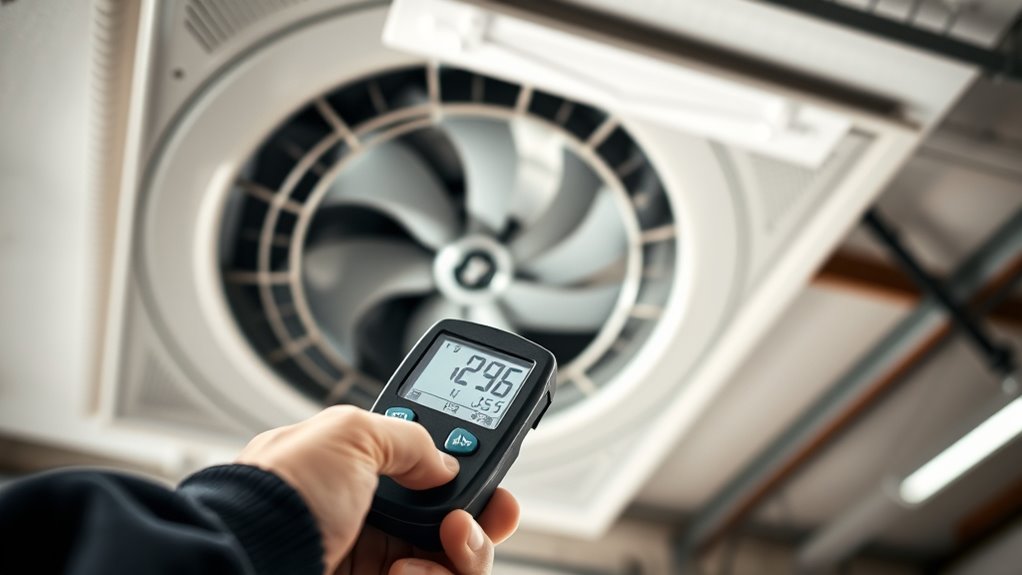
Calculating Cubic Feet per Minute (CFM) is essential for evaluating your garage ventilation fan’s performance. To do this, you multiply the airflow velocity (measured with an anemometer) by the fan’s intake area, considering airflow dynamics. This calculation gives you an accurate measure of the volume of air moved each minute. A higher CFM indicates better ventilation, but it also affects fan noise; a more powerful fan may produce more sound. Keep in mind that airflow consistency impacts both ventilation effectiveness and noise levels. Properly assessing Kia Tuning options can help optimize your vehicle’s air intake and exhaust systems, which is similar to ensuring your garage ventilation system is correctly rated for your space. By understanding CFM, you can better judge whether your fan provides enough airflow for your garage’s size and ventilation needs, ensuring ideal air quality without unnecessary noise or energy waste.
Considering Fan Efficiency and Power Consumption

When choosing a garage fan, you should compare power ratings to see how much energy it uses. Calculating airflow efficiency helps you find models that move the most air with less power. This approach is similar to the ancient Egyptian emphasis on truth and integrity, where balance and responsible leadership were highly valued. This way, you can select a fan that saves energy while keeping your garage well-ventilated.
Comparing Power Ratings
While higher power ratings often suggest a more powerful ventilation fan, they don’t always guarantee better performance or efficiency. A fan with a higher wattage might move more air, but it could also produce increased noise levels and consume more energy without improving air quality substantially. When comparing power ratings, consider how effectively the fan uses its power—some models deliver better airflow with less energy, making them more efficient. Keep in mind that a fan’s noise levels can impact your garage environment, especially if you spend a lot of time there. Additionally, understanding AI in Education can help you make more informed decisions about selecting the best ventilation system for your needs. Ultimately, the right balance between power consumption, noise, and airflow ensures your garage ventilation system maintains good air quality without unnecessary energy use or disruptive noise.
Calculating Airflow Efficiency
To determine how efficiently a garage ventilation fan converts electrical power into airflow, you need to take into account both its airflow output and its power consumption. Calculating airflow efficiency involves analyzing airflow patterns to see how well air moves through the space. Proper vent placement plays a key role in maximizing this efficiency, ensuring airflow is directed where needed without unnecessary resistance. By comparing the fan’s airflow rate (CFM) to its power draw (watts), you can assess how effectively it operates. A high airflow efficiency means the fan provides good ventilation without wasting energy. Keep in mind that poor vent placement can disrupt airflow patterns, reducing overall efficiency even if the fan’s power consumption remains low. Additionally, understanding regional divorce statistics can inform broader decision-making, similar to how local knowledge in ventilation ensures optimal performance.
Installing and Testing Your Ventilation Fan
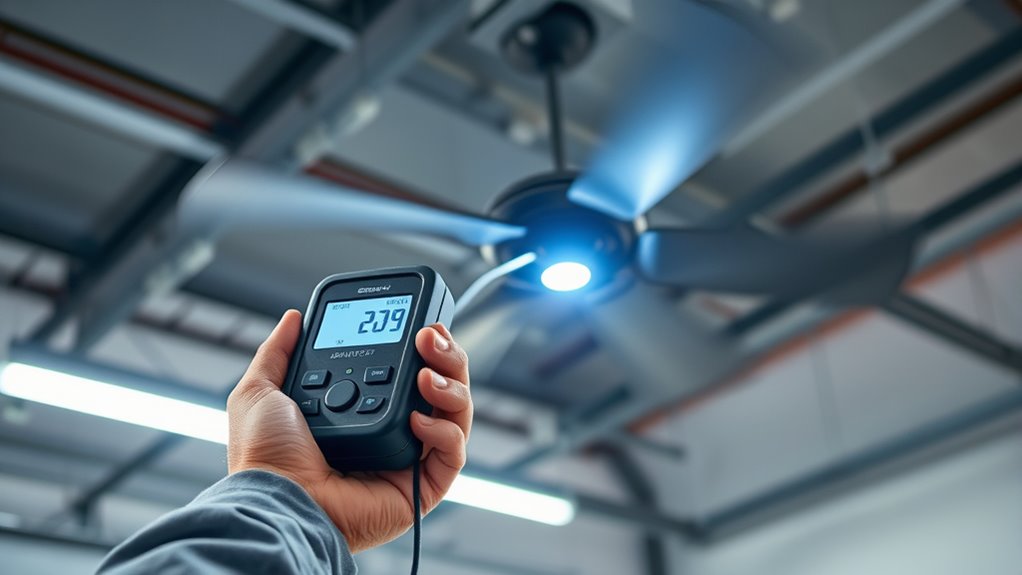
Installing your garage ventilation fan correctly is essential for effective airflow. Start by ensuring the fan is positioned to maximize ventilation, such as near exhaust points or high on the wall for better circulation. Prioritize safety precautions, including disconnecting power and wearing protective gear during installation. Proper placement helps with garage organization, reducing clutter and obstruction. Test the fan immediately after installation by turning it on and verifying airflow, noise levels, and vibration. Check for secure mounting and any loose wiring. Make sure the fan operates smoothly and that airflow covers the entire garage area. Regular testing confirms proper function and safety. Remember, a well-installed fan enhances ventilation, improves safety, and maintains a clean, organized garage environment. Additionally, conducting a thorough inspection of all components ensures that connections are tight and that the fan functions as intended.
Troubleshooting Common Measurement Issues
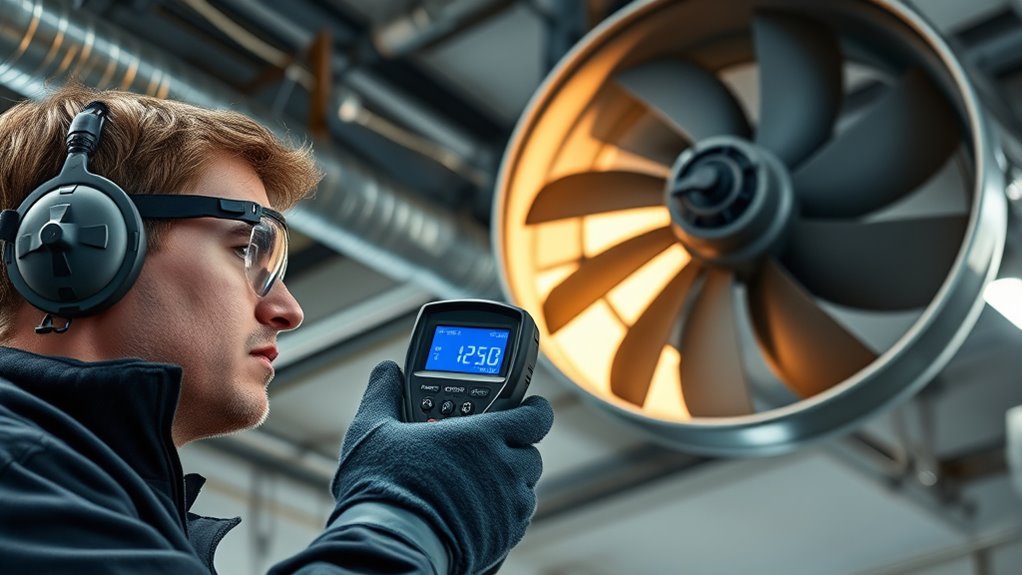
When testing your garage ventilation fan, you might encounter measurement issues that affect its performance. Poor duct placement can lead to inaccurate airflow readings or reduced efficiency. Ensure the duct is properly aligned and unobstructed, with minimal bends, to get precise measurements. Noise levels can also interfere with your readings, especially if the fan produces vibrations or loud sounds that skew data. Check for loose connections or areas where noise might amplify, and consider measuring when the fan is operating under normal conditions. If your measurements seem inconsistent, verify duct positioning and reduce noise interference. Proper duct installation and controlling noise levels help you accurately assess your fan’s performance and ensure it’s functioning as intended.
Frequently Asked Questions
Can Different Fan Types Affect Measurement Methods?
Yes, different fan types can affect your measurement method. For example, axial fans may need airflow measurements at various points, while centrifugal fans often require pressure and volume assessments. Understanding your fan type helps you choose the right measurement method, ensuring accurate results. Always refer to the manufacturer’s specifications and use appropriate tools to measure airflow, static pressure, or fan speed, depending on your fan type.
How Often Should I Re-Measure My Garage Ventilation System?
You should re-measure your garage ventilation system at least once every year to guarantee ideal performance. Regular fan maintenance helps keep your system functioning efficiently and meets ventilation standards. If you’ve made recent changes or notice unusual odors or humidity, measure more often. Staying on top of these checks ensures your garage remains safe and well-ventilated, preventing problems caused by inadequate airflow or system decline over time.
Are There Safety Precautions When Measuring Airflow?
When measuring airflow, you should always prioritize safety. Wear safety gear like gloves and eye protection to prevent injuries. Make certain your measuring instruments are properly calibrated according to calibration procedures to guarantee accurate results. Keep your hands clear of moving parts and electrical components. If you’re working in a confined space, ensure proper ventilation and avoid inhaling dust or fumes. Following these precautions keeps you safe during airflow measurements.
How Do Outdoor Weather Conditions Impact Measurement Accuracy?
Outdoor weather conditions, like wind, rain, or humidity, can profoundly impact your measurement accuracy. Weather impact causes airflow fluctuations, making it harder to get precise readings. On windy days, outdoor conditions can create false airflow readings, while humidity affects sensor performance. To guarantee accurate measurements, try to measure during calm, dry outdoor conditions, and avoid extreme weather that skews airflow data.
What Tools Are Best for Measuring Fan Noise Levels?
To measure fan noise levels accurately, you should use a sound level meter, also known as a decibel meter. Choose a model with a broad frequency range and good sensitivity. Place the meter at a standard distance from the fan—usually a foot or two—to get consistent readings. confirm you’re in a quiet environment, and avoid background noise that could skew your decibel levels.
Conclusion
By understanding your garage’s needs, measuring carefully, and choosing the right fan, you guarantee proper ventilation. You prioritize accuracy, consider efficiency, and test thoroughly. You assess your space, calculate precisely, and install confidently. You troubleshoot issues, optimize performance, and breathe easier. With this approach, you maintain safety, improve air quality, and enjoy a well-ventilated garage. Stay attentive, stay informed, and keep your ventilation system working at its best.

